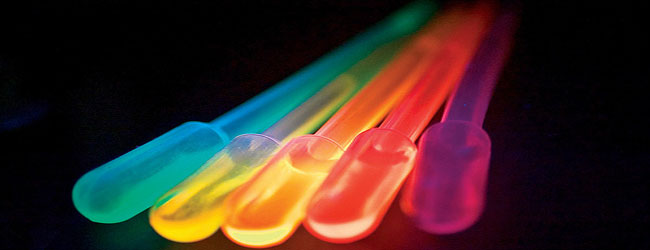Calcium isn’t only good for bones, it’s required by all cells as a ubiquitous player in signal transduction. It plays important roles in exocytosis, muscle cell contraction, and cell death cascades, among other things. It acts as an activator of numerous enzymes through calcium-binding proteins. Calcium concentrations in the cell cytoplasm are tightly regulated, and inability to do so frequently results in apoptosis.
And yet because calcium is a divalent ion, we are unable to study it directly through the typical ways that we might study gene or protein expression, like through quantitative PCR or Western blotting.
We can, however, use special dyes or engineered proteins to bind to calcium, indicating where in the cell it is. When used in combination with a fluorescence-detection method, the signal intensity of so called “calcium indicators” increases when calcium binds to the probe, providing information about relative or absolute calcium concentrations in targeted cell structures.
The trick is determining which probe is most suitable to your cells and application.
The following beginner’s guide should help address some of the issues to consider when choosing the appropriate calcium imaging approach.
Color me … green? Or red?
First and foremost, you are bounded by your detection method. Calcium indicators have a broad range of excitation/emission spectra varying from ultraviolet to far red wavelengths, but the most popular options exist in the blue/green or green/red light range. Just like any other fluorophore, knowing the fluorescence detection capabilities of your system is critical for determining which calcium indicators are options. Take a look at the filter cubes or laser lines in your system to determine which fluorophores you can detect.
One option that is limited by equipment for a different reason is the ratiometric dye. Dyes like fura-2 are uniquely excited at several wavelengths within the UV spectrum, and emit in the blue-green light range. While ratiometric imaging for calcium has the advantages of controlling for photobleaching or changes in focus, your imaging system must have the ability to rapidly oscillate between exciting at one wavelength, collecting one image, and then exciting at another wavelength and collecting another image. Essentially, your system has to be optimized for ratiometric imaging.
Most of us will likely be using the green or red fluorescing calcium indicators requiring only one image per time point. But there are still oh-so-many options!
If you are also using a GFP marker in your sample, then you need a red calcium indicator.
The greatest number of reagents are available in the blue/green excition/emission range, so try to reserve this channel for your calcium indicator.
To dye or use an encoded calcium indicator?
The two major methods of detecting calcium inside a cell are to add a dye, like fluo-4 that reversibly binds the ion, or to express a genetically-encoded calcium indicator (GECI), such as GCaMP. Like anything, each has advantages and disadvantages, but both are used for acutely prepared tissue, in cultured cells or in vivo with differing levels of success.
Which option you choose depends on your sample and your goals.
Using dyes
Calcium indicator dyes can be split into two categories based on how they are added to the cells. The cell-impermeable dyes are typically micro-injected or added via patch-pipet. This restricts the dye to one cell, or maybe a few cells if they are coupled by gap junctions. The cell-permeant yes, on the other hand, are linked to an ester group that facilitates the dye being taken up across the membrane. Inside the cell, the ester group is cleaved by naturally occurring enzymes, trapping the dye in the cell. Occasionally, the AM calcium dyes will compartmentalize into subcellular structures instead of remaining in the cytoplasm, making it challenging to measure changes in cytosolic calcium. This tends to happen more frequently at higher loading temperatures and can be minimized by using a dextran-conjugated dye.
In addition to loading mechanism, you should consider the dynamic range of the dye. This essentially refers to how bright a dye is at baseline when not bound to calcium, and how much the signal intensity increases when calcium binds. For instance, when calcium binds Oregon Green BAPTA-1, it has about a 14-fold increase in fluorescence, while fluo-4 has a greater than 100-fold increase. So if you had a sample with high background or auto-fluorescence, Oregon Green BAPTA’s range would probably not be sufficient to detect small changes in calcium concentration.
Using a genetically encoded calcium indicator
Encoded indicators, such as GCaMP, take advantage of a motif derived from the calcium binding protein, calmodulin. Unlike the indicator dyes, you transfect or transduce GECIs into cells and tissues, or create transgenic animals with promoter-driven cell-specific expression. Expression can be long lasting, making it possible to perform more than one imaging session on the same sample. GCaMP variants have been developed that target and tether the sensor to different parts of the cell, enabling detection of local calcium increases that may not be possible with dyes. The dynamic range and signal to noise ratios of some of the early generation non-ratiometric GECIs was lacking, but this has improved steadily with each successive generation putting them on par with some of the more robust calcium dyes.
These are just the first points to consider when choosing a calcium indicator for your experiments. For more detailed information, check out:
Molecular Probes Handbook, A Guide to Fluorescent Probes and Labeling Technologies, 11th Edition.
Whitaker, M. 2010. Genetically-encoded probes for measurement of intracellular calcium. Methods in Cell Biology. 99:153–182. https://dx.doi.org/10.1016/B978-0-12-374841-6.00006-2.






